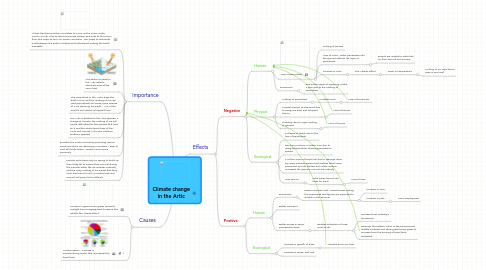
1. Causes
1.1. Increase in greenhouse gases prevents sunlight from escaping back to space this addsto the Abedo effect
1.2. Modernisation - Increase in manufacturing sector that is powered by fossil fuels
2. Importance
2.1. Allows the thermohaline circulation to occur as the ocean water cools in North Atlantic which becomes denser and sinks to the ocean floor that helps to form an ocean circulation. This helps to distribute heat between the Earth's coldest and hottest part making the Earth habitable
2.2. The white ice sheet in the Artic reflects about 85-90% of the sun's heat
2.3. The permafrost in the Arctic traps the Earth's CO2 and the melting of ice cap (and permafrost) will cause more release of CO2 warming the Earth - 11% of the world's soil carbon is trapped here
2.4. The Artic is habitat for the Artic species, a change in climate, the melting of ice will create difficulties for the species that lives on it and the whole food chain of the Arctic will corrupt (Artic also contains endemic species)
2.5. Provides the Inuit's income by providing marine mammals which are declining in numbers - 80% of Inuit still hunts fishes , caribou and marine mammals
2.6. Female polar bears rely on spring to build up their body fat to ensure their survival during the summer when the ice recedes naturally and the early melting of ice meant that they have less time to hunt (3 months less) and survival will prove to be difficult
3. Effects
3.1. Negative
3.1.1. Human
3.1.1.1. Loss of permafrost
3.1.1.1.1. Sinking of houses
3.1.1.1.2. Loss of rivers - water penetrates into the ground without the layer of permafrost
3.1.1.1.3. Increase in CO2
3.1.1.2. Economics
3.1.1.2.1. $30 billion spent of repairing Alaska a year due to the melting of permafrost
3.1.2. Physical
3.1.2.1. Melting of permafrost
3.1.2.1.1. Unstable land
3.1.2.2. Coastal erosion at Shismaref due to rising sea level and frequent storms
3.1.2.2.1. Loss of homes
3.1.2.3. Flooding due to rapid melting of glaciers
3.1.2.3.1. Loss of homes
3.1.3. Ecological
3.1.3.1. Collapse of forest due to the loss of permafrost
3.1.3.2. Decline in salmon in Yukon river due to rising temperatures allowing parasites to spread
3.1.3.3. 4 million acres of forest lost due to damage done by Kenia penisula spruce bark bettles which were prevented by cold winters but milder winters increased the species' survival dramatically
3.1.3.4. Less sea ice
3.1.3.4.1. Polar bears forced into town for meal
3.2. Positive
3.2.1. Human
3.2.1.1. Economics
3.2.1.1.1. Raise in tourism with 15,000 tourist visiting the Greenland and figures are expected to double in the summer
3.2.1.2. Better Transport
3.2.1.3. Better access in some inaccessible areas
3.2.1.3.1. Enables extraction of ores, cruel oil etc
3.2.2. Ecological
3.2.2.1. Increase in growth of trees
3.2.2.1.1. Absorbs more sun heat
3.2.2.2. Increase in prawn and cod
